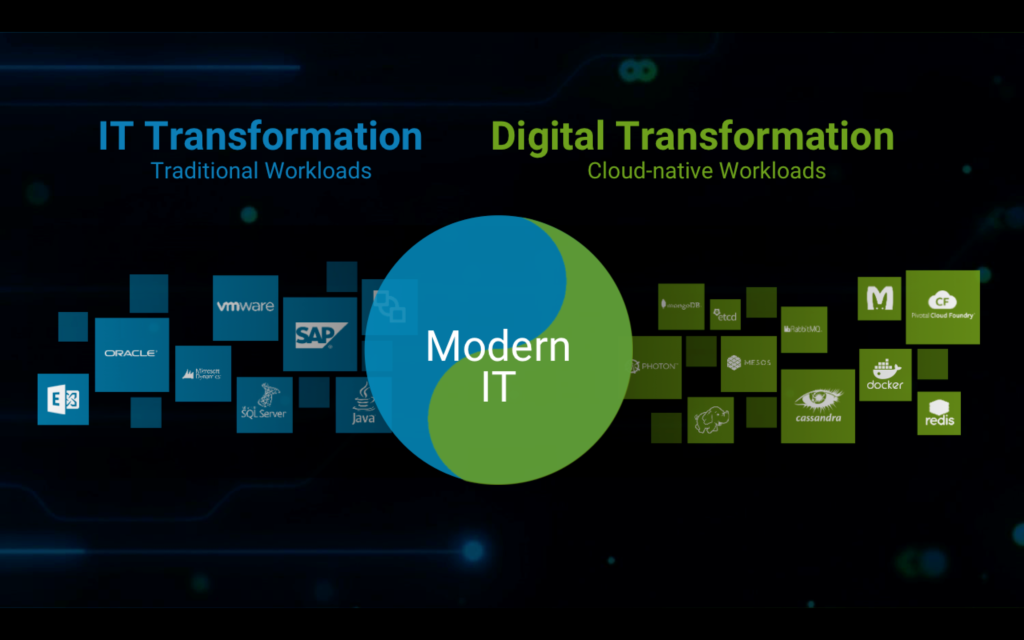The first Dell World concluded last week. The level of enthusiasm and excitement in the hallways was truly overwhelming. After only six weeks operating as one combined company, we made an incredibly fast and strong start by announcing a wave of new products and solutions that combine industry-leading technologies from the Dell Technologies family.
The announcements, keynotes, breakout sessions, and our customer, partner and influencer conversations all centered on Digital and IT Transformation. It’s now common knowledge that all industries are facing digital disruption as technology rapidly changes the way we work and live. With this tremendous digital opportunity comes a “digital fear” as organizations wrestle with how to drive opportunity, participate and succeed in a new digital era. Every type and sized organization in every industry is feeling pressure to become a digital enterprise.
This is demonstrated in a recent Dell Technologies study, in which nearly half of global business leaders from mid-size to large enterprises confessed to being unclear about what their industry would look like in three years. These leaders also believed that moving toward a cloud model, expanding software development capabilities and enabling faster innovation and deeper insights from data will be crucial to achieving digital transformation. There was also a revelation that the majority of organizations are struggling to evolve their data centers, with 69% saying they are being held back by too many traditional applications. They also face the challenge of reducing sprawl and spend, while bringing systems up-to-date.
How did the IT industry find itself in this position? And, what comes next?

Everything in IT is accelerating exponentially. Moore’s Law continues to hold true, as technology capabilities advance 10X every 5 years. That means that fifteen years ago, everything was 1000X slower than it is today. During this client-server era, IT focused on automating the back office, middle office and end users. IT systems-of-record were implemented with an emphasis on process, efficiency and reliability. Also, most of IT’s time was spent on implementing packaged traditional applications, instead of writing software.
Now, fast forward 15 years from today and you can expect to see technology capabilities to advance another 1000X. The implication will create a dramatically different era of IT. The Internet-of-Everything is quickly leading us down the path to IT-enabled businesses and economies.
There’s another profound shift happening: IT will move from supporting the business, to becoming the business.
Technology will be inherent in every part of the business. There will be a shift beyond systems of record, to systems of engagement and systems of insight that are focused on using IT Innovation for building new products, offerings and services. With this shift comes a renewed desire and requirement to write software that will lead to differentiating from – or displacing – competition. The ability to differentiate with software will continue to create winners and losers in every industry.
Most of my conversations with customers focus on how IT can affect and afford transformation.
The client-server era of spending has peaked at $2.7 trillion, according to analyst estimates. This was spent on traditional client-server applications that run today’s businesses, the traditional applications that are not going away any time soon.
As IT budgets are not growing exponentially, IT must focus on optimizing traditional applications and infrastructure to run traditional enterprise applications, like SAP and Oracle, more efficiently. By taking cost out of traditional IT, new digital initiatives may be funded more easily.
These new digital initiatives will be powered by cloud-native applications. The characteristics of these cloud-native applications are radically different in every way. They’re stateless, distributed and scale-out in nature, with resiliency built into the application, leveraging a DevOps development process. In addition, these applications have 1,000 more users per application, with each user generating 1,000X more data, leading to data sets that can be 1 million times larger than traditional environments.
For IT this presents a dual challenge: accelerate digital transformation to support the requirements of new cloud-native applications, while supporting the traditional applications that run today’s business. IT must be an expert and thought leader in both distinct architectural and operational paradigms.
The clearest path forward to transform IT and solve for this dual challenge is through a hybrid cloud strategy, which we believe will leverage multiple hybrid clouds.
- The first move to achieve this is to modernize the data center. Technology tenets like scale-out, flash, software-defined, and cloud-enabled are fundamental to a modern data center.
- Once a modern data center and its infrastructure have been established, the next step is to automate. Enabling a frictionless and self-service environment allows organizations to scale an operation and maintain reliability.
- And finally, transform to an IT-as-a-Service model.
Dell is committed to innovating so that customers have the infrastructure needed to transform, while juggling an increasingly diverse set of priorities.
Let the transformation begin…